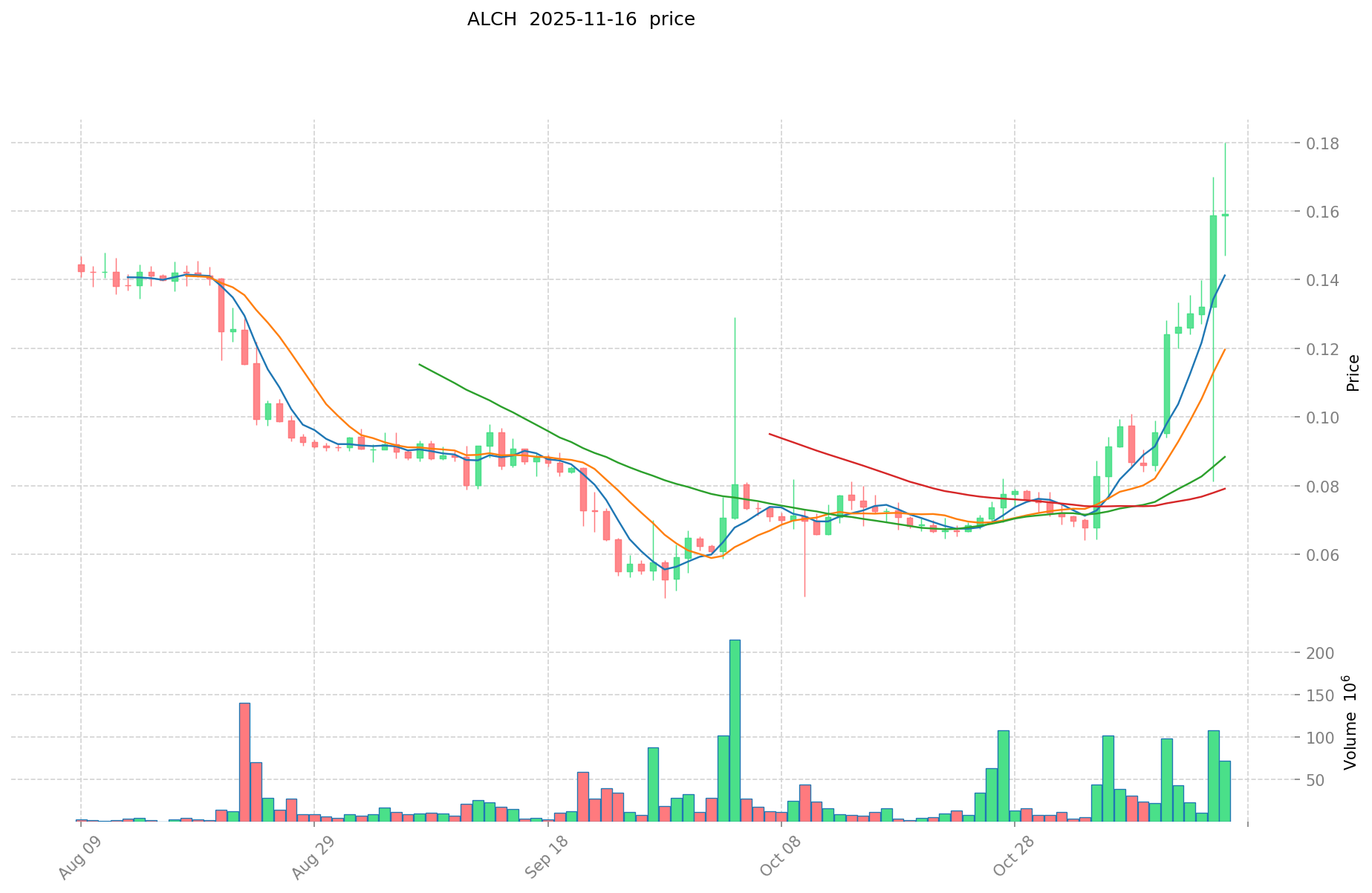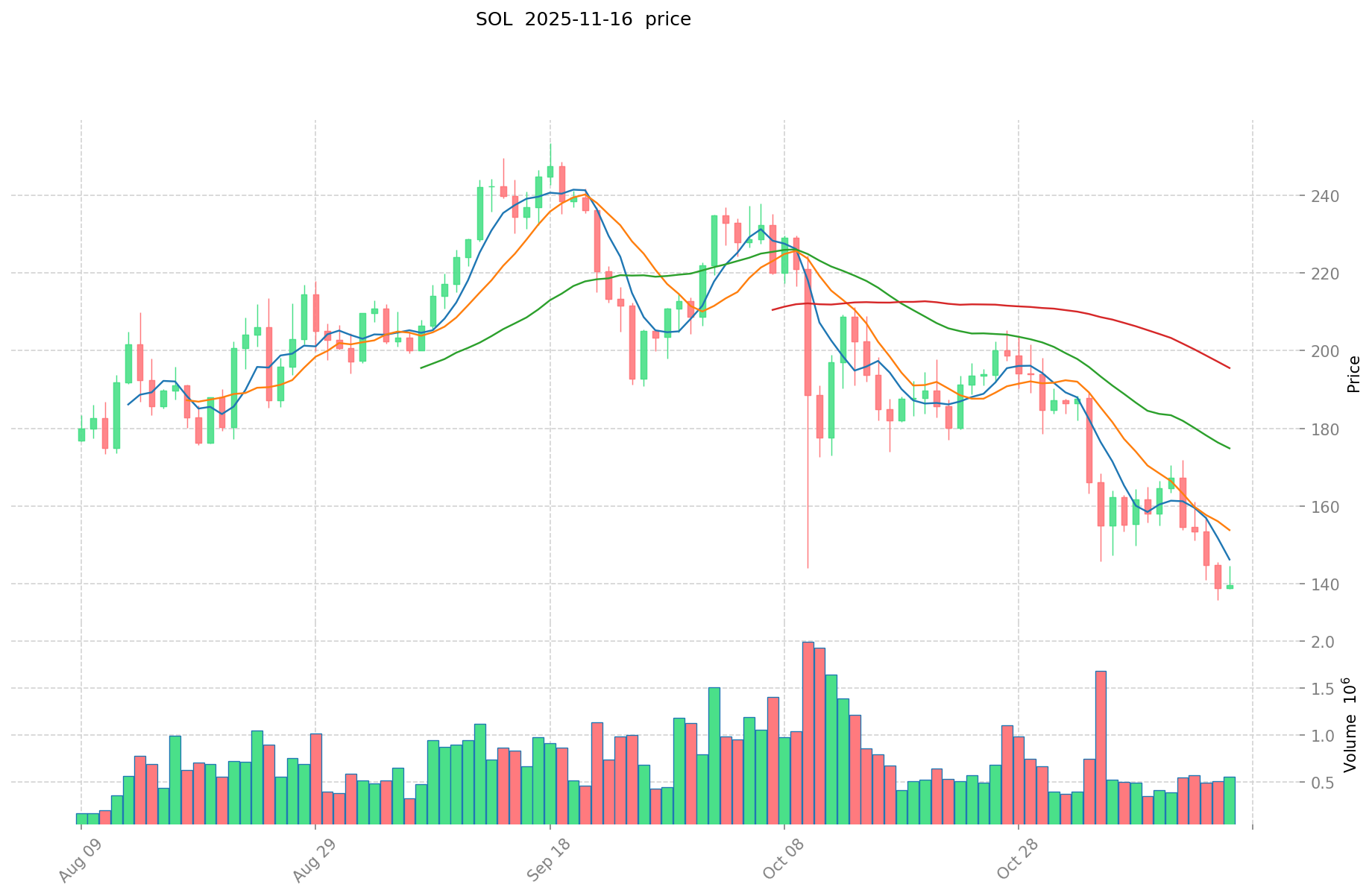ALCH vs SOL: Comparing Two Blockchain Ecosystems for DApp Development
Introduction: Investment Comparison of ALCH vs SOL
In the cryptocurrency market, the comparison between Alchemist AI vs Solana has been an unavoidable topic for investors. The two not only differ significantly in market cap ranking, application scenarios, and price performance, but also represent different positioning in crypto assets.
Alchemist AI (ALCH): Since its launch, it has gained market recognition for its no-code development platform capabilities.
Solana (SOL): Since its inception in late 2017, it has been hailed as a high-performance blockchain protocol, becoming one of the cryptocurrencies with the highest global trading volume and market capitalization.
This article will comprehensively analyze the investment value comparison between ALCH and SOL, focusing on historical price trends, supply mechanisms, institutional adoption, technological ecosystems, and future predictions, attempting to answer the question investors care about most:
"Which is the better buy right now?"
I. Price History Comparison and Current Market Status
ALCH (Coin A) and SOL (Coin B) Historical Price Trends
- 2025: ALCH reached its all-time high of $0.24039 on April 24, 2025, and its all-time low of $0.01405 on February 24, 2025.
- 2025: SOL experienced significant volatility, with its all-time high of $293.31 recorded on January 19, 2025.
- Comparative analysis: In the current market cycle, ALCH has shown remarkable growth, rising from its low point of $0.01405 to its current price of $0.15353, while SOL has declined from its peak of $293.31 to the current $141.78.
Current Market Situation (2025-11-16)
- ALCH current price: $0.15353
- SOL current price: $141.78
- 24-hour trading volume: ALCH $9,460,925.95 vs SOL $73,765,271.65
- Market Sentiment Index (Fear & Greed Index): 10 (Extreme Fear)
Click to view real-time prices:
- View ALCH current price Market Price
- View SOL current price Market Price


II. Core Factors Affecting Investment Value of ALCH vs SOL
Supply Mechanism Comparison (Tokenomics)
- ALCH: Alchemix has a token with an uncapped supply model, currently at around 4.5 million tokens in circulation.
- SOL: Solana features a disinflationary model with annual inflation that decreases over time, currently around 1.8% and projected to reach 1% long-term.
- 📌 Historical pattern: Solana's controlled inflation model has generally supported more predictable value accrual, while ALCH's uncapped model presents different tokenomic considerations.
Institutional Adoption and Market Applications
- Institutional holdings: SOL has gained significantly more institutional adoption, with major funds, VCs, and trading firms actively investing in the ecosystem.
- Enterprise adoption: SOL has seen wider integration in payment systems, NFT platforms, and enterprise applications, while ALCH remains more focused within DeFi lending and yield strategies.
- Regulatory stance: Both face varying regulatory scrutiny, with Solana's broader ecosystem attracting more regulatory attention across jurisdictions.
Technical Development and Ecosystem Building
- ALCH technical upgrades: Alchemix V2 brought significant protocol improvements including multi-collateral support and expanded yield-generating options.
- SOL technical development: Solana continues to address previous performance issues with validators, while improving throughput and implementing fee markets.
- Ecosystem comparison: Solana offers a much broader ecosystem spanning DeFi, NFTs, gaming, and payments with thousands of applications, while Alchemix focuses specifically on self-repaying loans and yield automation within DeFi.
Macroeconomic Factors and Market Cycles
- Inflation performance: SOL has demonstrated stronger market resilience during inflationary periods, likely due to its broader utility and institutional backing.
- Monetary policy impacts: Both tokens show sensitivity to interest rate changes, with SOL generally tracking broader crypto market reactions to monetary policy shifts.
- Geopolitical factors: SOL's wider global adoption makes it more susceptible to international regulatory developments, while ALCH remains more insulated within specialized DeFi use cases.
III. 2025-2030 Price Prediction: ALCH vs SOL
Short-term Prediction (2025)
- ALCH: Conservative $0.1366 - $0.1535 | Optimistic $0.1535 - $0.1596
- SOL: Conservative $129.11 - $141.88 | Optimistic $141.88 - $180.19
Mid-term Prediction (2027)
- ALCH may enter a growth phase, with prices expected between $0.1113 - $0.2245
- SOL may enter a consolidation phase, with prices expected between $122.32 - $180.08
- Key drivers: Institutional capital inflow, ETF, ecosystem development
Long-term Prediction (2030)
- ALCH: Base scenario $0.2919 - $0.3386 | Optimistic scenario $0.3386 - $0.3493
- SOL: Base scenario $225.38 - $331.31 | Optimistic scenario $331.31 - $350.00
Disclaimer: This analysis is for informational purposes only and should not be considered as financial advice. Cryptocurrency markets are highly volatile and unpredictable. Always conduct your own research before making any investment decisions.
ALCH:
| 年份 | 预测最高价 | 预测平均价格 | 预测最低价 | 涨跌幅 |
|---|---|---|---|---|
| 2025 | 0.1596192 | 0.15348 | 0.1365972 | 0 |
| 2026 | 0.220734936 | 0.1565496 | 0.104888232 | 1 |
| 2027 | 0.22448429892 | 0.188642268 | 0.11129893812 | 22 |
| 2028 | 0.2623353699942 | 0.20656328346 | 0.1383973999182 | 34 |
| 2029 | 0.349329496823379 | 0.2344493267271 | 0.121913649898092 | 52 |
| 2030 | 0.338591717659277 | 0.291889411775239 | 0.242268211773448 | 90 |
SOL:
| 年份 | 预测最高价 | 预测平均价格 | 预测最低价 | 涨跌幅 |
|---|---|---|---|---|
| 2025 | 180.1876 | 141.88 | 129.1108 | 0 |
| 2026 | 178.747518 | 161.0338 | 135.268392 | 13 |
| 2027 | 180.08409854 | 169.890659 | 122.32127448 | 19 |
| 2028 | 216.9843496748 | 174.98737877 | 108.4921748374 | 23 |
| 2029 | 254.78162348912 | 195.9858642224 | 190.106288295728 | 38 |
| 2030 | 331.3141034679672 | 225.38374385576 | 155.5147832604744 | 58 |
IV. Investment Strategy Comparison: ALCH vs SOL
Long-term vs Short-term Investment Strategies
- ALCH: Suitable for investors focused on DeFi yield strategies and self-repaying loan mechanisms
- SOL: Suitable for investors seeking broader ecosystem exposure and potential for institutional adoption
Risk Management and Asset Allocation
- Conservative investors: ALCH: 10% vs SOL: 90%
- Aggressive investors: ALCH: 30% vs SOL: 70%
- Hedging tools: Stablecoin allocation, options, cross-currency portfolios
V. Potential Risk Comparison
Market Risks
- ALCH: Higher volatility due to smaller market cap and narrower use case
- SOL: Susceptibility to broader crypto market trends and macroeconomic factors
Technical Risks
- ALCH: Scalability, network stability
- SOL: Validator concentration, potential security vulnerabilities
Regulatory Risks
- Global regulatory policies may have a more significant impact on SOL due to its wider adoption and use cases
VI. Conclusion: Which Is the Better Buy?
📌 Investment Value Summary:
- ALCH advantages: Specialized DeFi use case, potential for growth in yield automation
- SOL advantages: Established ecosystem, institutional adoption, broader utility across various sectors
✅ Investment Advice:
- New investors: Consider a higher allocation to SOL for its established position and broader ecosystem
- Experienced investors: Balanced approach with a tilt towards SOL, but include ALCH for diversification
- Institutional investors: Focus on SOL for its liquidity and established market presence, with potential small allocation to ALCH for exposure to innovative DeFi strategies
⚠️ Risk Warning: Cryptocurrency markets are highly volatile. This article does not constitute investment advice. None
VII. FAQ
Q1: What are the main differences between ALCH and SOL in terms of investment potential? A: ALCH is focused on DeFi yield strategies and self-repaying loans, suitable for investors interested in specialized DeFi applications. SOL offers exposure to a broader ecosystem including DeFi, NFTs, gaming, and payments, with more institutional adoption and wider market applications.
Q2: How do the supply mechanisms of ALCH and SOL differ? A: ALCH has an uncapped supply model, while SOL features a disinflationary model with decreasing annual inflation, currently around 1.8% and projected to reach 1% long-term.
Q3: Which token has shown better price performance in the current market cycle? A: In the current market cycle, ALCH has shown remarkable growth, rising from its low point of $0.01405 to $0.15353, while SOL has declined from its peak of $293.31 to $141.78.
Q4: What are the key factors affecting the long-term price predictions for ALCH and SOL? A: Key factors include institutional capital inflow, potential ETF approvals, and ecosystem development. By 2030, ALCH is predicted to reach $0.2919 - $0.3493, while SOL is expected to reach $225.38 - $350.00 in optimistic scenarios.
Q5: How should investors allocate their portfolio between ALCH and SOL? A: Conservative investors might consider allocating 10% to ALCH and 90% to SOL, while aggressive investors could opt for 30% ALCH and 70% SOL. The specific allocation should be based on individual risk tolerance and investment goals.
Q6: What are the main risks associated with investing in ALCH and SOL? A: ALCH faces higher volatility due to its smaller market cap and narrower use case, as well as potential scalability and network stability issues. SOL is more susceptible to broader crypto market trends and macroeconomic factors, with risks related to validator concentration and potential security vulnerabilities.
Share
Content